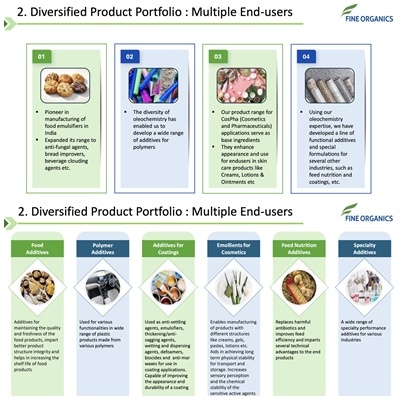Fine Organics is about to spend Rs 750 crore on expansion. Is it worth a buy?
With annual profits of around Rs 400 crore and over Rs 1,000 crore in cash and internal reserves, Fine Organics is deploying Rs 750 crore to build a new export-oriented plant in a SEZ in Maharashtra and its first manufacturing unit in the US. The question now is: can a company, known for its high return ratios and steady margins, scale globally while maintaining the discipline that has made it what it is?
 Fine Organics manufactures specialty additives, high-impact ingredients used across various industries, including food, plastics, cosmetics, and others. (Credit: fineorganics.com)
Fine Organics manufactures specialty additives, high-impact ingredients used across various industries, including food, plastics, cosmetics, and others. (Credit: fineorganics.com)In 2018, Fine Organics was trading at around Rs 1,000 per share. It was one of those compounders, profitable, low-debt, and steady, but largely ignored by the broader market.
Then came the breakout.
Between 2020 and mid-2022, the stock rallied more than 7 times, touching a high of nearly Rs 7,500. Investors who stayed in were rewarded handsomely. But the sharp run-up also brought volatility. Over the next 18 months, the stock corrected sharply, falling below Rs 4,000 by early 2024.
Now, it is climbing again.
As of July 2025, Fine Organics trades close to Rs 5,500, up nearly 40 per cent in just a few months. This recovery is coming at a time when the company is stepping into its most ambitious expansion yet.
With annual profits of around Rs 400 crore and over Rs 1,000 crore in cash and internal reserves, Fine Organics is deploying Rs 750 crore to build a new export-oriented plant in a Special Economic Zone near JNPA, Maharashtra. It is also laying the groundwork for its first manufacturing unit in the United States.
This is a company known for its conservative style, characterised by zero debt, high return ratios, and steady margins. However, it is now entering a high-capex, high-commitment phase that could shape the next decade.
The question is whether Fine Organics can scale globally while maintaining the discipline that has made it what it is.
 Figure 1: Stock Price Movement for Fine Organics. Source: Screener.in
Figure 1: Stock Price Movement for Fine Organics. Source: Screener.in
Business model and moat
At its core, Fine Organics manufactures specialty additives, high-impact ingredients used across various industries, including food, plastics, cosmetics, and others. These are not large-volume, commoditised chemicals. They are performance enhancers that improve texture, shelf life, dispersion, and stability in end products.
Its portfolio spans over 400 products, but they all follow a common thread: They are functional, high-margin, and deeply embedded in customer formulations, which makes Fine Organics a sticky supplier once trials succeed.
 Figure 2: Product Portfolio of Fine Organics. Source: Company’s Q4FY25 Report
Figure 2: Product Portfolio of Fine Organics. Source: Company’s Q4FY25 Report
Focused on niche
In FY25, about 55 per cent of revenue came from the polymer and plastic additives segment, followed by 30 per cent from food and feed, and the rest from cosmetics, coatings, and other specialty use cases.
What keeps the business strong is not just product diversity, but how tightly it controls quality and processes. Fine Organics does not rely on third-party innovation. It develops formulations in-house, builds trust with customers through trials, and then becomes part of their long-term supply chain. Switching costs are high.
Even though the company’s products form a small part of its customers’ overall cost, they play a critical role in performance. That makes pricing relatively resilient and helps sustain gross margins above 40 per cent, even during tough cycles.
 Figure 3: Consolidated Financials of Fine Organics. Source: Company’s Q4FY25 Report
Figure 3: Consolidated Financials of Fine Organics. Source: Company’s Q4FY25 Report
Private manufacturing with global reach
Fine Organics exports over 60 per cent of its products to more than 80 countries, and it does this with a single central R&D and production footprint based in India.
Fine Organics has historically focused on scaling without stretching. That is why, even with just over Rs 2,000 crore in revenue, it delivered a return on capital employed (ROCE) of 20 per cent and profit after tax of over Rs 400 crore in FY25.
The company maintains zero long-term debt, and most of its capital expansion so far has been self-funded. This gives it both financial flexibility and operational independence, a rare combination in the chemicals sector.
FY25 performance: Stability in margins, caution in growth
Fine Organics closed FY25 with revenue of Rs 2,095 crore, up 7 per cent year-on-year. While top-line growth was moderate, the company managed to protect its profitability in a high-cost environment.
- Gross margin stood at 41.5 per cent, nearly flat versus last year.
- EBITDA margin came in at 22.6 per cent, slightly lower than FY24’s 25.2 per cent but still healthy.
- Profit after tax was Rs 410 crore, compared to Rs 412 crore in FY24.
This flat but stable performance was not due to weak demand. It was largely a result of capacity constraints. The company operated at 95 percent utilisation, leaving little headroom for volume-led growth. This is why the upcoming capex becomes critical, as growth from here depends on adding new manufacturing lines.
One positive takeaway from FY25 is Fine Organics’ discipline in working capital. Receivables remain under control, inventory turnover has improved, and cash reserves crossed Rs 1,000 crore. The company remains debt-free.
Management has also guided that once the new SEZ facility is operational, likely in FY27, revenues could see a meaningful jump, with better operating leverage. Meanwhile, the company is also expanding R&D efforts and strengthening its global sales network, including the US setup.
Strategy and capex: From growth to global ambition
For most of the past decade, Fine Organics followed a low-risk, high-efficiency strategy. It avoided debt, expanded in phases, and focused on optimising capacity before chasing scale.
But that approach is now shifting. After reaching full utilisation across existing facilities, the company is preparing for its next growth phase.
Rs 750 crore SEZ bet
The largest capital investment in Fine Organics’ history is now underway, a new manufacturing unit inside the JNPA Special Economic Zone in Maharashtra. This facility is expected to cost around Rs 750 crore and will be geared mainly toward export markets.
Management shared in the May 2025 earnings call that land has already been allotted, and the project has received environmental clearance. The company expects commissioning by FY27, with a phased ramp-up in product lines.
This SEZ plant will:
- Help de-bottleneck capacity, which is currently operating at 95 percent
- Focus on new high-potential polymer and food additive applications
- Enjoy tax and logistics benefits from SEZ incentives and proximity to the port
Expanding to the United States
The bigger strategic leap, however, lies overseas.
For the first time, Fine Organics is planning a manufacturing unit in the United States. While exact numbers have not been disclosed, management hinted that the US capex could consume a large portion of the company’s Rs 1,000+ crore in cash and accruals over the next two years.
This decision has been driven by:
- Customer preference for local supply chains
- Opportunity to tap high-value, low-volume applications
- Mitigating regulatory and tariff risks by operating closer to developed markets
The company is still in the site selection phase, but has committed to setting up core R&D, pilot trials, and eventually full-scale manufacturing for high-margin segments like food, nutrition, and biodegradable plastics.
Management tone: Balanced optimism
In the latest conference call, the management emphasised two things:
- The company will not rush into adding volume. It will remain selective in products, pricing, and process scale-up.
- Despite the Rs 750 crore+ capex plan, debt will not be used, and the balance sheet will remain clean.
The company expects the next 12-24 months to be flat in terms of revenue growth, as most capacity remains tied up. But it sees significant operating leverage and margin upside once new capacities go live post-FY27.
Valuation and outlook: Is the stock still reasonably priced?
Fine Organics is no longer a secret. After its 7x rally between 2018 and 2022, and a recent bounce from the lows, the stock now trades around Rs 5,200, commanding a trailing P/E of 40 times. That is not cheap by traditional standards, especially for a company that reported just 7 per cent revenue growth in FY25.
But context matters.
Valuation in context
- The company generates over Rs 400 crore in annual profit and holds more than Rs 1,000 crore in cash
- Return on capital employed remains strong at over 20 percent, with zero long-term debt
- Margins have been stable despite inflation and near full-capacity operations
- The upcoming SEZ plant and US facility can add Rs 1,000-1,200 crore in revenue over the next few years if executed well.
While the P/E multiple may look high today, it reflects investor confidence that the next leg of growth will be driven by new capacity, new markets, and better operating leverage.
Key watchpoints
That said, investors must be mindful of a few risks:
- Execution delays in the SEZ or US expansion could drag timelines
- Regulatory hurdles or cost overruns could impact margins
- Global slowdown in demand for discretionary end-products (plastics, cosmetics, packaged food) may affect near-term volumes
- Currency volatility and freight costs could hurt export margins
Still, for long-term investors, Fine Organics represents a rare mix that is steady margins, strong cash flows, global potential, and conservative capital allocation.
The stock is not a value pick anymore. But it remains a business with high-quality fundamentals and a clear expansion roadmap.
If the company sticks to its discipline and delivers on execution, the next five years could look very different from the last five from both scale and relevance perspective.
Note: This article relies on data from annual and industry reports. We have used our assumptions for forecasting.
Parth Parikh has over a decade of experience in finance and research and currently heads the growth and content vertical at Finsire. He holds an FRM Charter and an MBA in Finance from Narsee Monjee Institute of Management Studies.
Disclosure: The writer and his dependents do not hold the stocks discussed in this article.
The website managers, its employee(s), and contributors/writers/authors of articles have or may have an outstanding buy or sell position or holding in the securities, options on securities or other related investments of issuers and/or companies discussed therein. The content of the articles and the interpretation of data are solely the personal views of the contributors/ writers/authors. Investors must make their own investment decisions based on their specific objectives, resources and only after consulting such independent advisors as may be necessary.






- 01
- 02
- 03
- 04
- 05

























